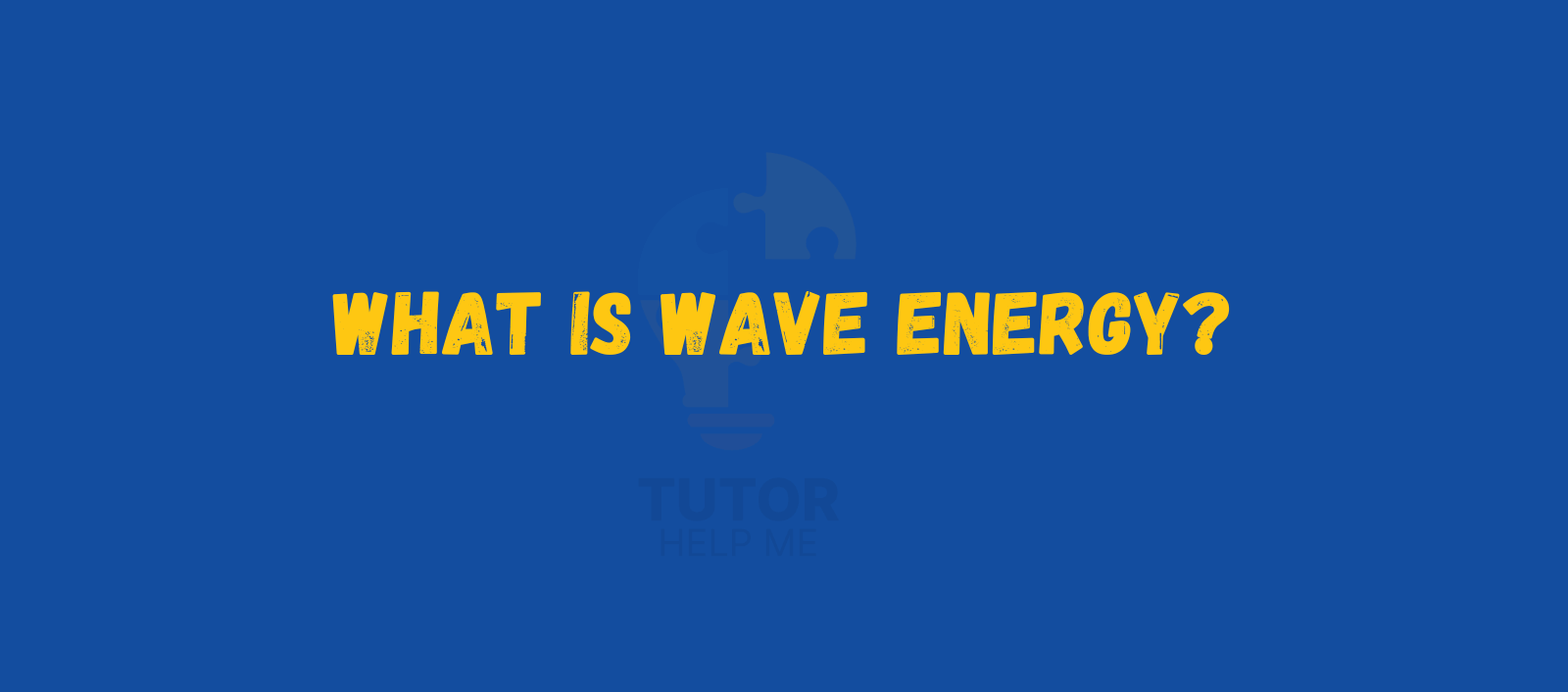Have you ever watched waves rolling on the beach and wondered if they could create power? The truth is, they can!
Wave energy is one of the most promising renewable energy sources on Earth. It uses the constant motion of ocean waves to create electricity.
This clean energy source has great potential to power homes, industries, and cities near the sea.
Let’s explore what is wave energy, how it works, and why it’s becoming so important in today’s world.
What Is Wave Energy?
Wave energy is the process of capturing the energy of ocean surface waves and converting it into useful power, such as electricity.
Wave energy is the energy produced by the movement of waves on the surface of the ocean. When the wind blows over the sea, it transfers energy to the water, forming waves.
These waves carry kinetic energy (motion energy) that can be captured and turned into electrical energy using special machines called wave energy converters (WECs).
Example:
When waves move a floating device up and down, that motion can be used to spin a turbine and generate power.
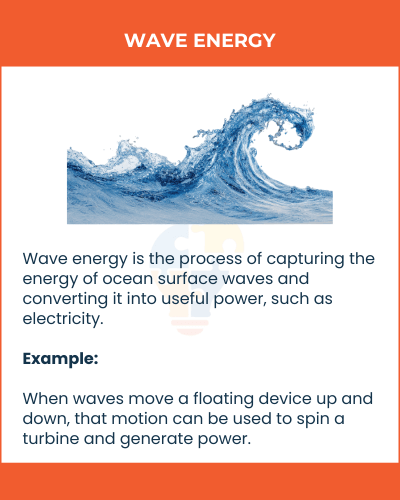
Why Is Wave Energy Important?
Wave energy is important because:
- It is renewable and will never run out.
- It helps reduce carbon emissions.
- It can generate electricity for coastal areas.
- It supports clean energy goals for the future.
The ocean covers over 70% of Earth’s surface, making wave energy one of the largest untapped energy sources in the world.
What Is a Wave Energy Converter?
A Wave Energy Converter (WEC) is a machine that captures the energy from ocean waves and converts it into electricity.
These devices come in many shapes and sizes. Some float on the surface, while others are fixed to the sea floor.
How It Works:
- The device moves with the motion of the waves.
- That motion powers a generator.
- The generator converts movement into electricity.
- The electricity is sent to power grids onshore.
Different Types of Wave Energy Converters
Wave energy converters work in different ways, depending on how they capture wave movement. Below are the main types:
Attenuators
Attenuators are long, jointed floating machines that lie parallel to the direction of the waves. As waves pass along them, the joints move up and down.
This movement drives hydraulic systems that generate electricity.
Example:
The “Pelamis Wave Energy Converter” used this method to produce clean power in Scotland.
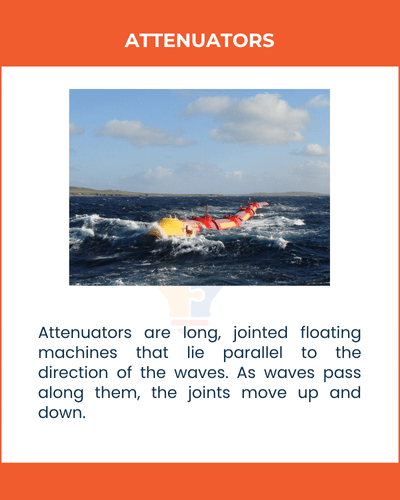
Point Absorbers
Point absorbers are floating structures that move with the rise and fall of waves. They generate power by converting this vertical motion into energy.
They are small but very efficient, especially in deep waters.
Example:
A buoy that bobs up and down in the ocean to create energy.
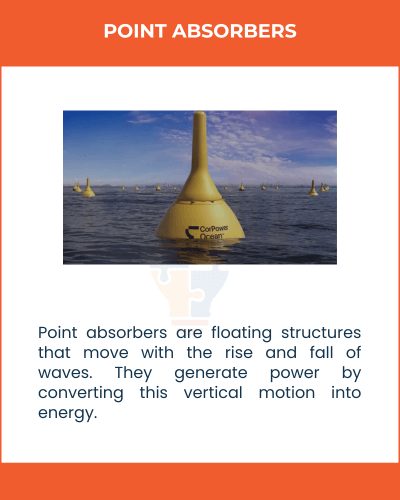
Oscillating Wave Surge Converter
These devices have panels that move back and forth with the motion of waves near the shore.
The movement pushes a hydraulic system or turbine to generate electricity.
Example:
Used in shallow coastal areas where waves surge toward the shore.
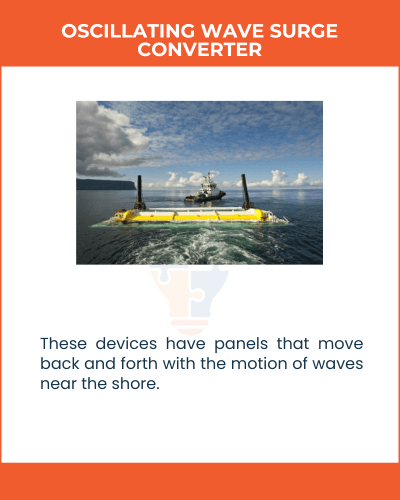
Oscillating Water Column (OWC)
An oscillating water column uses a partially submerged chamber open to the sea below. As waves move in and out, air inside the chamber moves up and down.
The moving air spins a turbine, which generates power.
Example:
The OWC plant on the island of Islay in Scotland uses this method effectively.
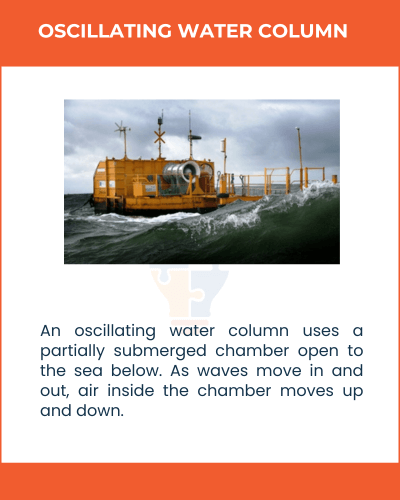
Overtopping / Terminator Device
This device collects water from incoming waves into a raised reservoir. The stored water then flows down through turbines, creating electricity, much like a hydroelectric dam.
Example:
The “Wave Dragon” device uses overtopping to generate continuous energy.
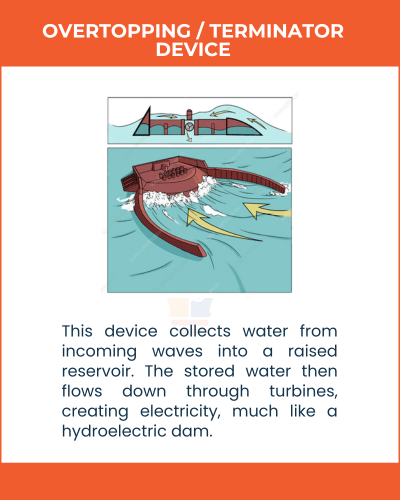
Submerged Pressure Differential
This type of converter sits underwater. When waves pass above it, the changing water pressure moves a flexible surface.
That movement drives a generator, converting mechanical energy into electricity.
Example:
Ideal for areas with small surface waves but strong underwater currents.
Bulge Wave
Bulge wave converters use a long rubber tube filled with water. As waves pass, pressure changes create bulges inside the tube.
These bulges move toward one end and drive a turbine to generate energy.
Example:
The “Anaconda” project in the UK tested this method successfully.
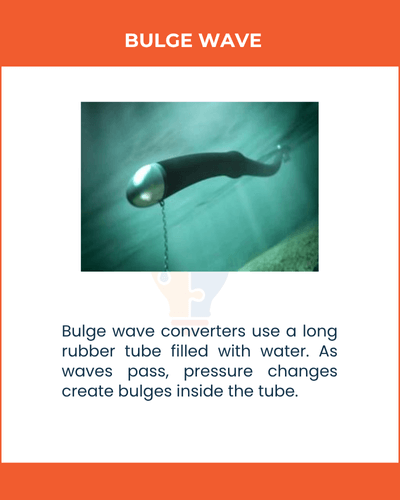
Rotating Mass
Rotating mass devices use the motion of waves to spin internal parts inside a floating structure.
The rotating parts convert movement into electrical energy through a generator.
Example:
Used in deep-water projects where large waves are common.
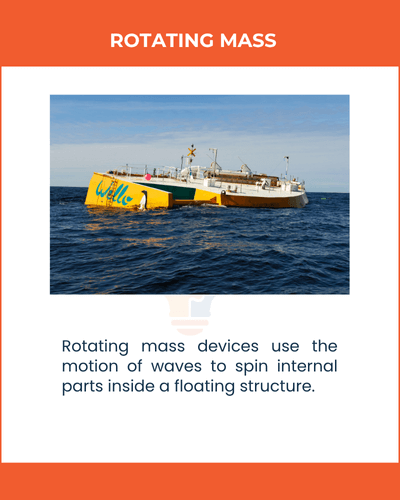
Advantages of Wave Energy
Wave energy offers several benefits that make it an attractive choice for clean power.
Renewable Source
Waves are produced by the wind, which is driven by the sun. As long as the sun shines, waves will exist, making wave energy renewable and unlimited.
Clean and Environmentally Friendly
It produces no greenhouse gases or harmful waste. It helps fight climate change and reduces our dependence on fossil fuels.
Predictable and Consistent
Unlike solar or wind energy, waves are more predictable. Ocean patterns can be studied, making it easier to forecast energy output.
Space Efficient
Wave energy devices can be installed offshore, saving valuable land space.
Supports Coastal Communities
It can provide steady electricity to towns and cities near the coast, improving energy security.
How Does Wave Energy Work?
Wave energy works by capturing the motion of waves and turning it into electric power through several steps:
Wave Motion
Waves carry energy as they move across the ocean.
Energy Capture
A wave energy converter absorbs this motion through floating or underwater structures.
Conversion to Mechanical Energy
The motion of the waves moves parts of the device, creating mechanical energy.
Conversion to Electrical Energy
The mechanical energy drives a turbine or generator, producing electricity.
Transmission
Cables carry the electricity to the shore, where it is distributed through the power grid.
Step-by-Step Example
Let’s take an Oscillating Water Column (OWC) as an example:
- Waves enter the chamber and push air upward.
- The air pressure turns a turbine.
- As the wave recedes, air flows back, again spinning the turbine.
- The turbine connects to a generator that produces electricity.
- The electricity is sent to homes through undersea cables.
Challenges of Wave Energy
Even though wave energy has great potential, it faces some challenges:
- High Cost: Building and maintaining offshore systems is expensive.
- Durability: Devices must withstand strong storms and saltwater corrosion.
- Environmental Impact: Some designs can affect marine life habitats.
- Energy Transmission: Transferring energy from the sea to land can be difficult.
Scientists and engineers are working to improve these systems to make wave energy cheaper and more efficient.
Future of Wave Energy
Wave energy has a bright future. Many countries are investing in ocean-based renewable energy projects.
With ongoing research, wave energy could soon supply clean electricity to millions of homes around the world.
Experts believe that wave and tidal energy could provide up to 10% of global electricity needs by 2050.
Real-Life Examples of Wave Energy Projects
- Mutriku Wave Power Plant (Spain): One of the world’s first commercial wave power plants.
- Oyster Project (Scotland): Converts nearshore wave energy into electricity for homes.
- CETO Project (Australia): Uses submerged devices to generate power and desalinate water.
- Wave Dragon (Denmark): Captures overtopping waves to produce electricity.
Fun Facts About Wave Energy
- The power of waves comes from the sun’s heat and the rotation of the Earth.
- A single ocean wave can carry thousands of kilowatts of energy.
- The world’s largest wave energy potential lies in the Pacific Ocean.
- Wave energy can operate day and night, unlike solar panels.
Difference Between Wave Energy and Tidal Energy
| Feature | Wave Energy | Tidal Energy |
|---|---|---|
| Source | Caused by wind over the sea | Caused by the gravitational pull of the moon and sun |
| Location | Surface of the ocean | Coastal areas with tides |
| Predictability | Moderately predictable | Highly predictable |
| Equipment | Floating or underwater converters | Barrages, turbines |
Conclusion
Wave energy is one of the most powerful and reliable renewable energy sources on Earth. It turns the natural movement of ocean waves into clean electricity without polluting the environment.
By learning what is wave energy, its types, and advantages, we understand how nature’s endless motion can help build a sustainable future.
As technology improves, wave energy could become a key player in solving global energy needs, making the ocean not just a mystery of beauty, but a source of power for all.
Read More What is Light Energy?
FAQs
Q1: What is wave energy in simple words?
A: Wave energy is the energy produced by the movement of ocean waves, used to generate electricity.
Q2: How does wave energy work?
A: It captures the motion of waves and converts it into electrical power using wave energy converters.
Q3: What is a wave energy converter?
A: A device that captures and transforms the kinetic energy of waves into electricity.
Q4: Is wave energy renewable?
A: Yes, it’s renewable because it comes from wind-driven ocean movement.
Q5: What are the types of wave energy converters?
A: Attenuators, point absorbers, oscillating water columns, overtopping devices, and submerged pressure systems.
Q6: What is the main advantage of wave energy?
A: It is clean, renewable, and predictable compared to other sources.
Q7: What is the difference between wave and tidal energy?
A: Wave energy comes from surface waves; tidal energy comes from tides.
Q8: Where can wave energy be used?
A: In coastal regions to power homes, industries, and cities.
Q9: Is wave energy costly?
A: Currently yes, but costs are falling as technology improves.
Q10: Does wave energy harm marine life?
A: Most designs are eco-friendly, though care is taken to minimize impact.
Q11: What countries use wave energy?
A: The UK, Portugal, Spain, Denmark, and Australia lead in wave power research.
Q12: What is an oscillating water column?
A: A chamber where moving air from waves spins a turbine to create power.
Q13: Can wave energy work at night?
A: Yes, waves move continuously, so energy generation doesn’t stop at night.
Q14: Is wave energy efficient?
A: Yes, wave energy can convert up to 50% of wave motion into usable power.
Q15: What is a point absorber?
A: A floating buoy that moves with waves to generate electricity.
Q16: What are the challenges of wave energy?
A: High cost, maintenance, and durability against harsh ocean conditions.
Q17: How much power can wave energy produce?
A: The world’s oceans could produce up to 2 terawatts of electricity.
Q18: Is wave energy available everywhere?
A: It’s best suited for coasts with strong and consistent waves.
Q19: Why is wave energy not widely used?
A: It’s still developing, and technology needs improvement.
Q20: What is the future of wave energy?
A: With innovation, it can become one of the world’s main renewable energy sources.

